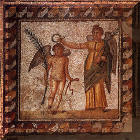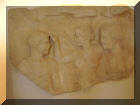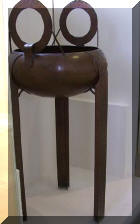PRIZES- DEDICATIONS
The disposition of the ancient Greeks towards competition was directly interwoven with the concept of victory and the prize. Depictions of athletic victories along with surviving prizes or dedications and the inscriptions on them, are important sources of evidence. Directly after the end of every event, there was a preliminary announcement of the winner, to whom a prize was awarded. The palm-branch was the first symbol of victory, presented to the winner by the judge Hellanodikes, along with a purple woolen band that he wore around his head. The official prizes were awarded at the end of the games to all the champions together, in the pronaos (ante-chamber) of the great temple of Zeus, the victors were crowned with the kotinos, a wreath from the "fair-crowned olive" that grew behind the temple. The wreath had a general symbolic significance for the ancient Greeks, who believed that It brought good fortune and divine protection and sanctified the person crowned with it.
 |
 |
||
| Roman Times mosaic depicting the athlete's wreathing by Nike, Larisa, Archaeological Museum. | Marble dedicative anaglyph depicting the winner's wreathing, Athens, Acropolis, 410 B.C. |
After sacrifices had been offered in honor of Zeus, an official celebratory banquet was held in the Prytaneion and the names of the champions were registered in the official archives of the Eleians kept in the Bouleuterion at Olympia. The Hellanodikai then granted the winner the right to commission a statue of himself from a sculptor and erect it in the sanctuary at Olympia. According to the literary sources, the custom of dedicating statues of Olympic champions in the sanctuary probably began in the 6th c. BC Evidence for the statues, mainly bronzes, executed by great sculptors (Onatas,Kalamis. Myron, Pythagoras, Polykleitos and Lysippos) is provided by references in Pausanias and Inscribed statue bases, on which the names of the dedicator, the event and the artist were inscribed.
The champions often made dedications in the sanctuary that were connected with the kind of event in which they had distinguished themselves. Examples are provided by the Inscribed halter (jumping-weight) of the Lakedaimonian athlete Akmatidas, and the bronze discus of Publius Asklepiades of Corinth. One of the most popular, and therefore most numerous dedications at Olympia were tripod cauldrons From the period of Homer onwards tripods were looked upon as valuable objects and given as presents and as prizes at games. In the case of the tripods found in the sanctuary at Olympia, views differ as to whether the were awarded as prizes before being dedicated to Zeus.
When the champions returned to their native cities, they were given a welcome on a par with that for generals returning from victorious campaigns. They entered the city riding in a four-horse chariot through a section of the fortification wall that was demolished for the purpose. The champion dedicated his wreath to the patron deity of the city, on whose altar he offered a sacrifice. He enjoyed certain privileges for life, such as free meals in the Prytaneion, exemption from taxes, and seats of honour in the theatre and at festivals and games.
Poets wrote victory hymns in honour of the champions.
Famous Olympic champions in ancient times include Milon of Kroton, Diagoras of Rhodes, Theagenes of Thasos, Leonidas of Rhodes, Eubatos of Cyrene, and others.



